“Due to growing cases of COVID-19 in many parts of the country, market conditions appear to be trending in a similar pattern to that seen earlier in the pandemic. More organizations in Wave 16 reported occupancy rate declines over the past 30 days in the segments serving residents with higher levels of care needs as the pace of move-ins has slowed. The deepest occupancy rate declines were in the nursing care segment, with about one-third of organizations with nursing care beds reporting occupancy declines of three percentage points or more. Residents moving to higher levels of care, cited by one-half of respondents, may be one of several possible factors in greater shares of organizations reporting an acceleration in move-outs for each of the care segments. As potential new residents wait on the sidelines and delay moving into properties, operators remain challenged to backfill newly available units. Recent announcements of vaccine approvals should help restore occupancy in the coming months.”
--Lana Peck, Senior Principal, NIC
NIC’s Executive Survey of operators in seniors housing and skilled nursing is designed to deliver transparency into market fundamentals in the seniors housing and care space at a time when market conditions continue to change. This Wave 16 survey includes responses collected November 9- 22, 2020 from owners and executives of 87 seniors housing and skilled nursing operators from across the nation. Detailed reports for each “wave” of the survey, and access to the graphs included in this report, can be found on the NIC COVID-19 Resource Center webpage under Executive Survey Insights.
Wave 16 Summary of Insights and Findings
- The shares of organizations reporting month-over-month declines in occupancy rates increased for each of the care segments except for the independent living segment in Wave 16. Notably, the shares of organizations reporting declines in occupancy is the highest since Wave 8 (surveyed late-May to early-June) for the memory care and nursing care segments, and Wave 9 for the assisted living care segment (surveyed late-June to early-July). On the flip side, the shares of organizations reporting an increase in month-over-month occupancy is the lowest in since Wave 8 for the independent living and assisted living care segments, and Wave 7 for the nursing care segment (surveyed mid-May).
- The shares of organizations reporting an acceleration in the pace of move-ins in the past 30 days for independent living, assisted living and memory care were at or around their lowest levels since Wave 8 (surveyed late-May to early-June), while the shares of organizations reporting a deceleration in the pace of move-ins in the past 30 days for independent living, memory care and nursing care were at or around their highest levels since Wave 8.
- The slowdown in the pace of move-ins may be reflected in the growing share of organizations reporting residents waiting to move in. Now at the highest point in the survey, approximately one-third of respondents (34%) had a backlog of residents waiting to move in. This may suggest that once a vaccine is distributed, operators may see an increase in move-ins and occupancy rates.
- Presumably due to relaxation in resident visitation restrictions, safe visitation policies and procedures, and perhaps greater access to COVID-19 testing, resident or family member concerns cited as a reason for deceleration in the pace of move-ins and acceleration in the pace of move-outs were both down from the late summer months.
- One-half of operators with nursing care beds noted downward changes in occupancy rates, and greater shares of organizations with nursing care beds in Wave 16 noted declines in occupancy of ten percentage points or more than in the prior three waves of the survey. About one-third of organizations with nursing care beds reported occupancy declines of three percentage points or more.
- On the other end of the spectrum, the independent living segment saw a lesser degree of month-over-month occupancy change than the nursing care segment: one-quarter of organizations with independent living units in Wave 16 noted occupancy declines of up to 3 percentage points, and 15% saw increases in occupancy up to 3 percentage points. Just under a third of the occupancy declines reported for the assisted living care segment were in the 0.1 to 3 percentage point range (29%), although one-quarter (25%) reported declines of more than 3 percentage points. Only 5% reported declines of 10 percentage points or more.
- Looking at the week-over-week occupancy changes by care segment, the nursing care and memory care segments reported the largest shares of declining occupancy from one week prior (33% and 23%, respectively), suggesting the downward trend may continue.
- In Wave 16, accelerations in the pace of move-ins in the past 30 days generally matched decelerations in independent living and memory care. However, the assisted living segment and the nursing care segment saw greater shares of organizations reporting decelerations in move-ins than accelerations. While resident or family member concerns and slowdown in leads conversions/sales cited as reasons for deceleration in move-ins (61%) declined from Wave 15 (88% and 75%, respectively), about one-quarter of respondents cited an organization-imposed ban (24%).
- The shares of organizations with assisted living units reporting an acceleration in the pace of move-outs is at the highest level in the survey time series (29%) but at similar levels seen last in Waves 5 and 6, earlier in the pandemic (late-April to mid-May). About one-third of organizations with nursing care beds in Waves 15 and 16 report an acceleration in the pace of move-outs—the highest levels since Wave 5 (surveyed late-April to early-May).
- Respondents reporting ease in accessing PPE and COVID-19 test kits declined from the prior survey. Just under one-half of respondents (47%) found it easy to obtain COVID-19 testing kits, down from 59% in Wave 15. Respondents reporting easy access to PPE fell from 54% to 44% over the same time period. The Wave 17 survey, currently collecting data, will address challenges to organizations regarding access and cost of PPE.
- Similar to Wave 15, more than one-half of respondents in Wave 16 (57%), received their COVID-19 test results within 2 days, up from 13% in Wave 10, surveyed late-July to early-August. While somewhat encouraging, at this point in the pandemic, it is still taking 3 or more days to receive test results for a substantial proportion of respondents (43%).
- Although down slightly from Wave 14, most respondents (85%) were paying staff overtime hours—continuing to put strain on NOI. Organizations backfilling staffing shortages with agency or temporary staff is down from a high of 70% in Wave 15 to 62% in Wave 16.
Wave 16 Survey Demographics
- Responses were collected November 9-November 22, 2020 from owners and executives of 87 seniors housing and skilled nursing operators from across the nation. Just under half of respondents are exclusively for-profit or nonprofit providers (44%, respectively), and 12% operate both for-profit and nonprofit seniors housing and care organizations.
- Owner/operators with 1 to 10 properties comprise 69% of the sample. Operators with 11 to 25 properties make up 17% of the sample, while operators with 26 properties or more make up 14% of the sample.
- Many respondents in the sample report operating combinations of property types. Across their entire portfolios of properties, 70% of the organizations operate seniors housing properties (IL, AL, MC), 30% operate nursing care properties, and 38% operate CCRCs (aka Life Plan Communities).
Key Survey Results
Pace of Move-Ins and Move-Outs
Respondents were asked: “Considering my organization’s entire portfolio of properties, overall, the pace of move-ins and move-outs by care segment in the past 30-days has…”
- Showing the most recent waves of survey data in the chart below, the shares of organizations reporting no change in the pace of move-ins in the past 30-days remained high but declined from Wave 15 for the independent living, assisted living and memory care segments—ranging from 49% to 52% in Wave 15 to 42% to 47% in Wave 16.
- In Wave 16, reports of accelerations in the pace of move-ins generally matched decelerations in independent living and memory care. However, the assisted living segment and the nursing care segment saw greater shares of organizations reporting decelerations in move-ins than accelerations.

- The shares of organizations reporting an acceleration in the pace of move-ins in the past 30-days for independent living, assisted living and memory care were at or around their lowest levels since Wave 8 (surveyed late-May to early-June). On the flip side, the shares of organizations reporting a deceleration in the pace of move-ins in the past 30-days for independent living, memory care and nursing care were at or around their highest levels since Wave 8.
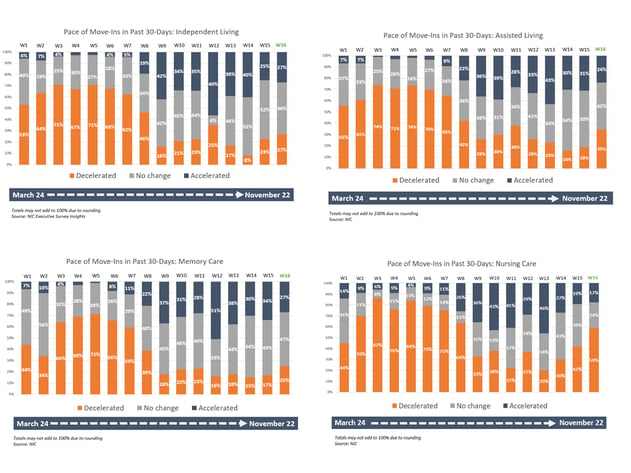
Reasons for Acceleration or Deceleration in Move-Ins
Respondents were asked: “The acceleration/deceleration in move-ins is due to…”
- The shares of organizations citing increased resident demand as a reason for acceleration in move-ins in Wave 16 remained high (84%); up from a low of 66% in Wave 10 (surveyed mid-July to early-August) but down from a peak of 88% in Wave 12 (surveyed mid- to late-September).
- As shown in the chart below, resident or family member concerns and slowdown in leads conversions/sales cited as reasons for decelerations in the pace of in move-ins in the past 30-days (61%) declined from Wave 15 (88% and 75%, respectively). In Wave 16, about one-quarter of respondents cited an organization-imposed ban—an increase from the prior wave (17% to 24%), and up from 0% in Wave 14 (surveyed mid- to late-October).
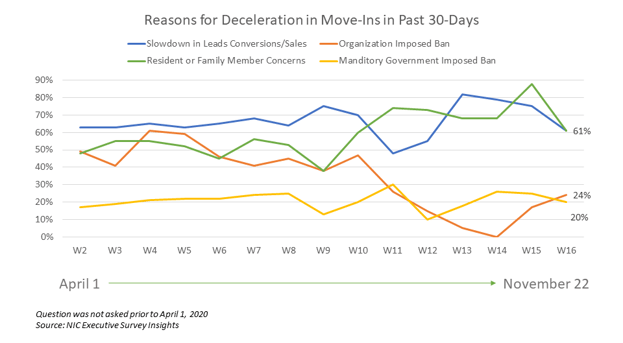
- In Wave 16, the shares of organizations reporting an acceleration in the pace of move-outs exceeded the shares reporting a deceleration in move outs for each of the care segments. However, between roughly two-thirds and three-quarters of respondents in Wave 16 with independent living, assisted living, and/or memory care units noted no change in the pace of move-outs in the past 30-days (61% to 79%).
- While smaller shares of organizations with independent living units reported deceleration in move-outs than in the prior three waves of the survey (7%), greater shares of organizations with assisted living and memory care units than in recent waves of the survey reported acceleration in the pace of move-outs (29% and 22%, respectively).

- About one-third of organizations with nursing care beds in Waves 15 and 16 report an acceleration in the pace of move-outs—the highest levels since Wave 5 (surveyed late-April to early-May).
- The shares of organizations with assisted living units reporting an acceleration in the pace of move-outs is at the highest level in the survey time series (29%) but at similar levels last seen in Waves 5 and 6 earlier in the pandemic (late-April to mid-May).
- As shown in the chart below, resident deaths (unspecified reason) continued to be cited most frequently as a reason for acceleration in the pace of move-outs in the last 30-days (77%). This is up from 61% in Wave 13 but below the peak of 85% reached in Wave 6 (surveyed in early-May). Residents moving to higher levels of care was cited by one-half of respondents (51%)—the highest since Wave 7 (surveyed mid-May). Resident or family member concerns cited as a reason for acceleration in the pace of move-outs was 40% in Wave 16—down from 63% in Wave 10 (surveyed late-July to early-August).
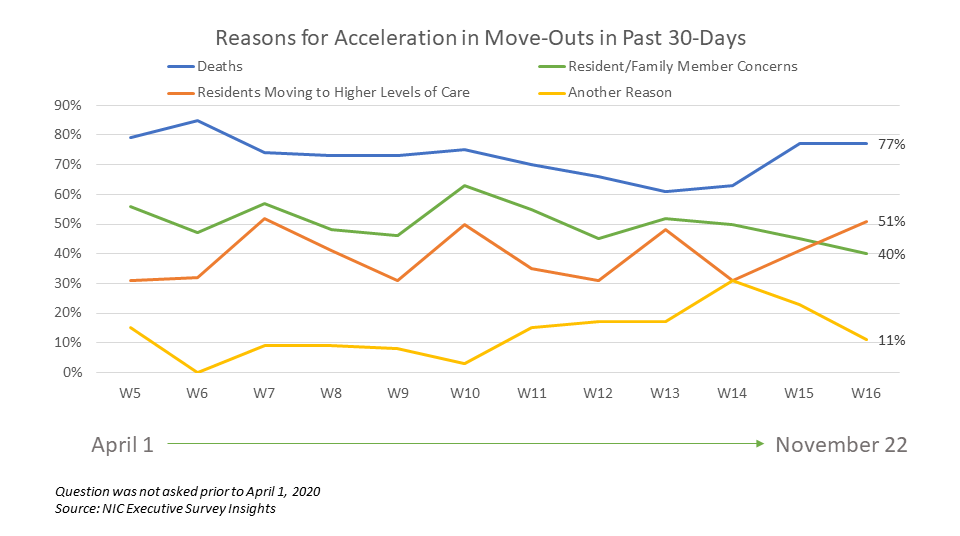
Change in Occupancy by Care Segment
Respondents were asked: “Considering the entire portfolio of properties, overall, my organization’s occupancy rates by care segment are… (Most Recent Occupancy, Occupancy One Month Ago, Occupancy One Week Ago, Percent 0-100)”
- In Wave 16, the shares of organizations reporting month-over-month declines in occupancy rates increased for each of the care segments except for the independent living segment. Between 42% and 54% of organizations with assisted living units, memory care units and nursing care beds reported downward changes in occupancy in the past 30-days.
- The shares of organizations reporting declines in occupancy is the highest since Wave 8 (surveyed late-May to early-June) for the memory care and nursing care segments, and Wave 9 for the assisted living care segment (surveyed late-June to early-July).
- The shares of organizations reporting an increase in month-over-month occupancy is the lowest in since Wave 8 for the independent living and assisted living care segments, and Wave 7 for the nursing care segment (surveyed mid-May).
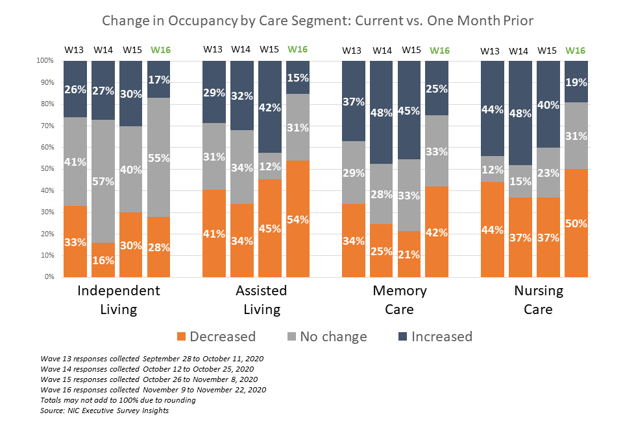
- The chart below breaks out the rates of change in occupancy by care segment with greater granularity. The blue and orange-hued stacked bars correspond to the solid bars in the chart above indicating the degree of change by the saturation of color.
- The chart above illustrates that In Wave 16, 50% of operators with nursing care beds noted downward changes in occupancy rates. The chart below describes the degree of those occupancy rate changes: greater shares of organizations with nursing care beds in Wave 16 noted declines in occupancy of ten percentage points or more than in the prior three waves of the survey (greater shares of organizations also reported increases of ten percentage points or more). Additionally, the chart shows that about one-third of organizations with nursing care beds reported occupancy declines of three percentage points or more.
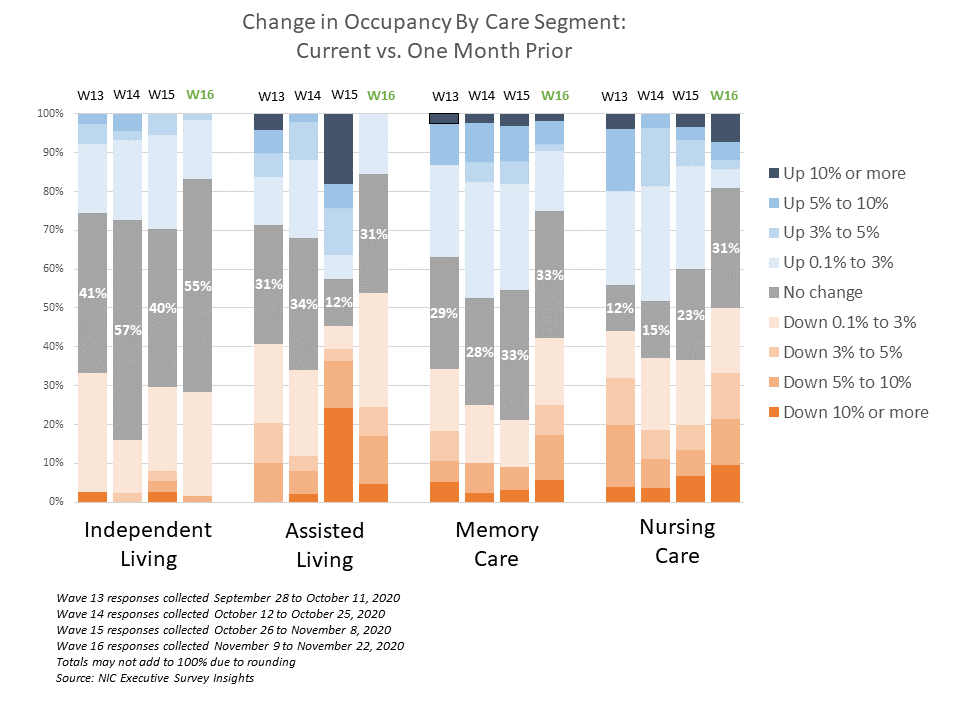
- On the other end of the spectrum, the independent living segment saw a lesser degree of occupancy change than the nursing care segment: one-quarter of organizations with independent living units in Wave 16 noted occupancy declines of up to three percentage points, and 15% saw increases in occupancy up to three percentage points.
- Just under a third of the occupancy declines reported for the assisted living care segment were in the 0.1 to three percentage points range (29%), although one-quarter (25%) reported declines of more than three percentage points. Only 5% reported declines of ten percentage points or more.
- Regarding the change in occupancy from one week ago, between 62% and 87% of organizations with independent living, assisted living and memory care, and 50% of organizations with nursing care beds reported no change. Organizations with independent living units saw the smallest changes in week-over-week occupancy rates (7%, decreased and 7% increased). However, the nursing care and memory care segments reported the largest shares of declining occupancy from one week prior (33% and 23%, respectively).

Organizations Currently Offering Rent Concessions to Attract New Residents and Organizations Experiencing a Backlog of Residents Waiting to Move-In
Respondents were asked: “My organization is currently offering rent concessions to attract new residents,” and “My organization is experiencing a backlog of residents waiting to move-in”
- Fewer organizations in the Wave 16 survey sample were offering rent concessions to attract new residents than in the prior three waves of the survey. Organizations offering rent concessions (51%) is down from a high of 61% reached Wave 14 (surveyed in the latter half of October). It should be noted that the concept of “rent concessions” is broad and may include non-monetary benefits.
- Approximately one-third of respondents (34%) indicated that their organizations had a backlog of residents waiting to move in. This has increased to the highest point in the survey.
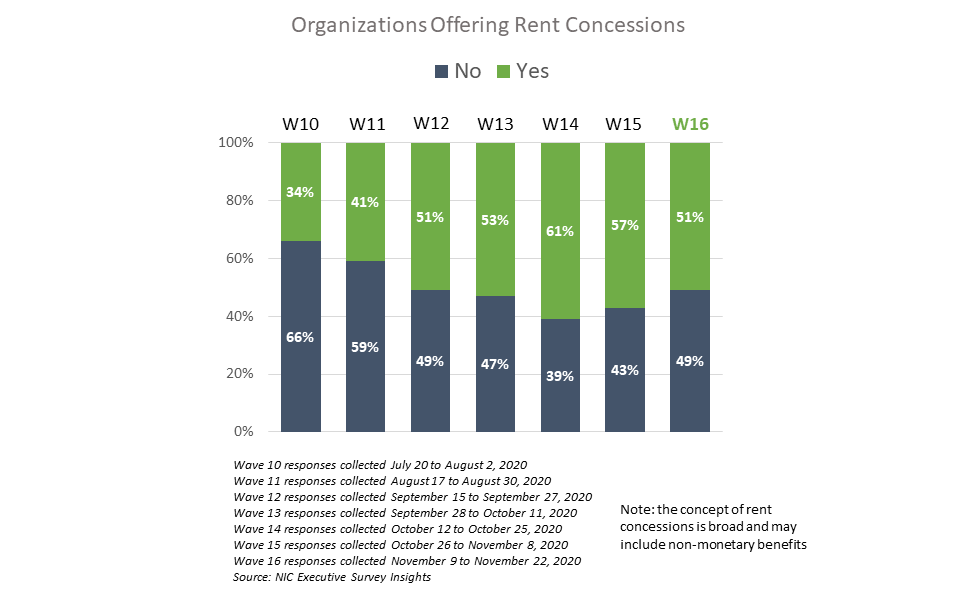
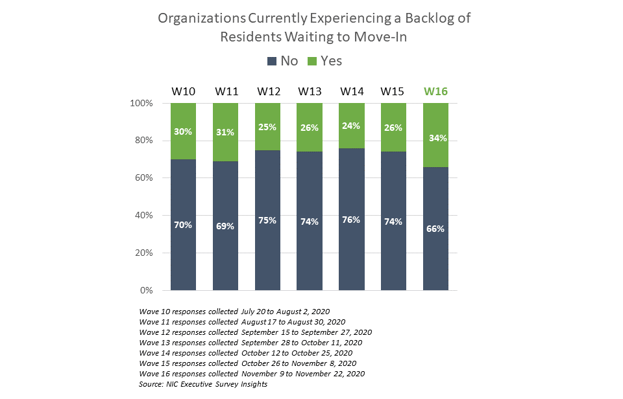
Improvement in Access to PPE and COVID-19 Testing Kits
Respondents were asked: “Considering access to PPE (personal protective equipment) and COVID-19 testing kits, my organization has experienced that access has improved... Very little, it is still difficult to obtain enough PPE/testing kits in most markets/Somewhat, in some markets it is easier to obtain PPE/testing kits than in others/Considerably, we typically have no difficulty obtaining PPE/testing kits, regardless of market”
- Respondents reporting ease in accessing PPE and COVID-19 test kits declined from the prior survey. Just under one-half of respondents (47%) found it easy to obtain COVID-19 testing kits, down from 59% in Wave 15. Respondents reporting easy access to PPE fell from 54% to 44% over the same period.

- The next survey, Wave 17, will address challenges to organizations about access to and cost of PPE.
Time Frames for Receiving Back COVID-19 Test Results
Respondents were asked: “Regarding COVID-19 test results (either for staff, residents or prospective residents) results typically come back within…”
- Like Wave 15, more than one-half of respondents in Wave 16 (57%), received their COVID-19 test results within 2-days, up from 13% in Wave 10, surveyed late-July to early-August. At this point in the pandemic, it is still taking 3 or more days to receive test results for a substantial proportion of respondents (43%).

Labor and Staffing
Respondents were asked: “My organization is backfilling property staffing shortages by utilizing … (Choose all that apply).” Note: this question was asked in Wave 3, and then again in Waves 10-16.
- Although down slightly from Wave 14, most respondents in Wave 16 (85%) were continuing to offer staff overtime hours. Just under two-thirds of respondents were using agency or temp staff to fill staffing vacancies—62% up from 36% in Wave 3 but down from 70% in Wave 15.

Owners and C-suite executives of seniors housing and care properties, we’re asking for your input! By providing real-time insights to the longest running pulse of the industry survey you can help ensure the narrative on the seniors housing and care sector is accurate. By demonstrating transparency, you can help build trust.
“…a closely watched Covid-19-related weekly survey of [ ] operators
conducted by the National Investment Center for Seniors Housing & Care…”
Wall Street Journal | June 30, 2020
The Wave 17 survey is available until Sunday, December 13, and takes just 5 minutes to complete. If you are an owner or C-suite executive of seniors housing and care and have not received an email invitation to take the survey, please click this link or send a message to insight@nic.org to be added to the email distribution list.
NIC wishes to thank survey respondents for their valuable input and continuing support for this effort to bring clarity and transparency into market fundamentals in the seniors housing and care space at a time where trends are continuing to change.
About Lana Peck
Lana Peck, former senior principal at the National Investment Center for Seniors Housing & Care (NIC), is a seniors housing market intelligence research professional with expertise in voice of customer analytics, product pricing and development, market segmentation, and market feasibility studies including demand analyses of greenfield developments, expansions, repositionings, and acquisition projects across the nation. Prior to joining NIC, Lana worked as director of research responsible for designing and executing seniors housing research for both for-profit and nonprofit communities, systems and national senior living trade organizations. Lana’s prior experience also includes more than a decade as senior market research analyst with one of the largest senior living owner-operators in the country. She holds a Master of Science, Business Management, a Master of Family and Consumer Sciences, Gerontology, and a professional certificate in Real Estate Finance and Development from Massachusetts Institute of Technology (MIT).
Connect with Lana Peck
Read More by Lana Peck